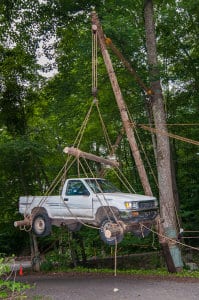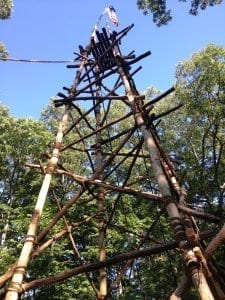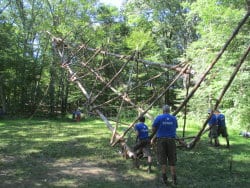Backwoods Engineering Resources
Resources for the Do It Yourselfer
This page contains a variety of resources for folks interested in doing this sort of work on their own or developing a pioneering program for their camp/council. Below you’ll find step by step photos detailing the design considerations and construction sequences of some large projects, basic plans and materials lists for a variety of other projects, and links to helpful books and websites created by others.
DISCLAIMER. READ THIS FIRST
The Backwoods Engineering projects and activities described on this website are all potentially dangerous. The materials presented on these pages are no substitute for your experience, skill, good judgment, and common sense. If you lack any of these, please do not proceed. None of the materials on these pages contain all of the information that you will need to complete the project. Gain experience with small low-risk projects before attempting larger more dangerous ones. Every project that you undertake should have a single responsible adult in charge who bears absolute responsibility for participants’ health and safety.
Use these materials at your own risk. The Boy Scouts of America, Patriots Path Council, Mount Allamuchy Scout Reservation, and the individuals who generated the content for this website expressly disclaim any liability arising from your use of these materials. If you attempt projects or activities shown here under the auspices of the Boy Scouts of America please consult the Guide to Safe Scouting and all other applicable regulations before beginning, as they may impose restrictions on your activities that differ from those that we face.
This section contains step by step photo essays showing the construction of some of the large pioneering projects that we have built. When you are designing a pioneering project, it is important to consider not just the appearance of the finished project, but also that your design is structurally sound and allows the project to be built using a safe and efficient sequence. You might find the sequences, techniques, and design considerations shown and described here useful even if you do not intend to build any of the specific projects described below.
This photo shows the construction of a 100’ Monkey Bridge across a 25’ deep gorge. This bridge incorporates a system of interlocking stringers that is more secure than the straight stringers commonly used on monkey bridges. It also incorporates a simple fall protection system that allows individuals crossing the bridge to be harnessed in at all times.
This photo shows the construction of a 30’ signal tower with four legs. A scale drawing of this tower can be seen here. The most challenging parts of this project are ensuring that the tower’s legs are properly aligned (so that the tower will not be lopsided) and handling the heavy subassemblies. The tower is built to completion on its side so that Scouts do not have to work at heights when building the tower. Erecting the tower is treated in a separate document.
DESCRIPTION COMING SOON
Notes: It is safest to build a signal tower on its side, but this leaves you with the problem of erecting it upon completion. The method shown here uses a lever spar/shear legs and a block and tackle to raise a heavy 30’ tower. Lightly built towers up to 20’ in height can often be raised using only the lever spar/shear legs.

DESCRIPTION COMING SOON
Building a derrick is a great project for teaching Scouts about engineering principles including vectors, tension, compression, shear, and block and tackles. The derrick shown here can lift a load of about three tons, but a smaller derrick is constructed exactly the same way. The construction is pretty straightforward, but you will need some pulleys and other rigging gear. This project requires at least two block and tackles and two appropriately sized snatch blocks.
Below are plans for other projects that we have built. Once we decide on a new project that we want to build, we make a scale drawing and use this to work out a construction sequence and materials list. The drawings shown below contain very limited information about the safety precautions and construction sequences that we followed when building these projects, and you should treat them only as a starting point for tackling these projects.
Bridges
Towers
- 15’ Brynbach Tower
- Steps for Building a Three-Legged Tower
- 15’ Three Legged Signal Tower
- 40’ Three Legged Signal Tower and Rigging Plan
- 18’ Four Legged Signal Tower
- 20’ Four Legged Signal Tower
- 30’ Four Legged Signal Tower
- Rigging Plan to Erect a 30’ Tower
- 10’ Modified Peschke Ladder Tower
- 20’ Stilt Tower
Other
- 3-Ton Derrick
- Paddlewheel Raft
- Sail Raft
Note: This raft proved very unstable under sail power, but the basic frameworks well with paddles if built without the mast.
Here are some other web and print sources that you might find useful.
Web Pages
- Ropesandpoles.blogspot.com
A blog about Pioneering by a South African Scouter that shows unconventional projects/techniques, a variety of large projects, and large rafts. - Scoutpioneering.com
Larry Green’s blog, featuring excellent coverage of basic skills, smaller projects including many camp gadgets, and fun activities for troop meetings and campouts. - www.makerope.com
Information about the rope making process for the farmer/ hobbyist and the seller of the hand-cranked rope making machine that we use. - www.pioneeringprojects.org and Pioneering Projects Big and Small
Two collections of sketches of Pioneering Projects and Camp Gadgets. A great source of inspiration. - www.thedump.scoutscan.com
A group of Canadian Scouters has amassed a collection of Scouting books and pamphlets that have entered the public domain. The John Thurman books linked below come from this web page.
Books and Pamphlets
- FM 5-125 Rigging Techniques Applications & Procedures (Defense Department, 1995)
Lots of useful information including: knots and splices, working with block and tackles, safe working loads of common ropes and cables, setting up and using gin poles, shear legs, and derricks, types and holding capacities of anchor systems, compressive strength of wooden timbers, calculating forces in guy lines, derricks, and ropeways, and much more. - John Thurman’s Books
John Thurman was an English Scouter and camp director who wrote extensively on Pioneering in the 1950s and 1960s. Thurman’s books include skill instruction and sketches and descriptions of dozens of useful and fanciful pioneering projects. Bear in mind when reading Thurman, that he seems not to have built some of the projects that he describes, and some of the sketches in his books defy the laws of physics and/or feasible construction. Nonetheless, they remain an excellent source of ideas and information. The good folks at www.thedump.scoutscan.com have made Thurman’s books available for free download.- Fun with Ropes and Spars (1956)
- Pioneering Principles (1962)
- Pioneering Projects (1961)
- Progressive Pioneering (1964)
- Pioneering Merit Badge Pamphlet (Boy Scouts of America, Multiple editions)
The current edition of this book is available at most Scout shops but is not recommended. Earlier revisions are much better. If you want to buy a book about pioneering, find a used copy of an earlier revision or buy a copy of Scout Pioneering (John Sweet, 1974) from Scouts Canada.- The current revision (2006-present) of the pamphlet is not very good, containing numerous errors, and replacing much of the useful content from older editions with flashy, but not terribly informative, graphics. Don’t bother building the rope making machine shown in this edition. It is too lightly built to work reliably.
- The 1993 revision of the pamphlet, written by Adolph Peschke, contains a large section of useful knots, recommended gear for a troop pioneering kit, a color coding system for ropes and spars, and building instructions for many small to medium size bridges and a simple tower. Don’t bother building the rope making machine shown in this edition. It is too lightly built to work reliably.
- The 1967 revision (and identical 1974 edition) of the pamphlet contains information about the construction of large bridges and towers and permanent bridges that do not appear in subsequent editions. Much of the material from this revision is reprinted in the 1967 edition of the Scout Fieldbook.
- The 1942 revision of the pamphlet by Walter H. McIlroy contains information about the permanent construction of bridges, towers, rafts, and trails, working with block and tackles, the long splice, and careers (circa 1940) in engineering and related fields.
- Scout Pioneering by John Sweet (1974)|
Sweet was a colleague of John Thurman. The first half of his book focuses on skills and principles, and the second half gives instructions for building specific projects. Sweet’s book contains fewer projects than Thurman’s books, but they are all buildable and are more comprehensively presented. It is still in print and available inexpensively from Scouts Canada at https://www.scoutshop.ca/.
Hard to Find Books
The following books are all out of print and difficult to find, but well worth reading if you run across them.
- A Manual of Elementary Seamanship, 8th ed. (Capt. D.Wilson Barker, 1919).
A textbook for Junior Officers written at the end of the era of merchant sailing ships. Includes extensive information on knots, splices, and rigging; most notably including illustrated instructions to remove and re-step the masts of a square-rigged sailing ship using only equipment carried onboard and a clever method of calculating the loads on the component parts of a derrick from a sketch without the use of formulas or complex math. - FM 5-10 Engineer Field Manual: Communications, Construction, and Utilities (War Department, 1940)
Extensive information about assembling pontoon bridges and floating them into place, launching prefabricated bridges across a gap with a launching beam, calculating the capacity of truss bridges, building timber trestle bridges, rigging generally, and much more. - FM 21-105 Basic Field Manual, Engineer Soldier’s Handbook (War Department, 1943)
An updated and abbreviated (1/3 the length) version of FM 5-10. Contains information on bridging, rigging, anchorages, and the proper use of woods tools. - Instructions for United States Coast Guard Stations 1934 (US Treasury Dept., Coast Guard, 1934)
Contains illustrated instructions showing how to rig and use a breeches buoy to remove the crew and passengers of a grounded ship. This would make a fun activity at a camporee or summer camp. - TM 5-225 Rigging and Engineer Hand Tools (War Department, 1942)
A precursor to FM5-125. It assumes that the soldier will have limited access to power sources and power equipment compared to the later manual. Its second half lists the hand tools contained in common military toolkits of the day and provides brief instruction on their proper use. - Useful Knots and How to Tie Them (Plymouth Cordage Company, 1946)
A short pamphlet of basic knots and splices. Contains an excellent explanation of the relative strength of knots and splices, including high-speed photography of a knotted rope breaking under tension.
Mount Allamuchy Scout Reservation
750 Waterloo Road
Stanhope, NJ 07874
(973) 347-2240 (in season)
Reservation Director
Dave Lage • (973)271-0793
SUMMER CAMP
Camp Somers Program Director
James Hitchings • 973-765-9322 x419
Camping Services
Richard Hawkins • (973) 765-9322 x225
WEEKEND PROGRAM
Carl Zipper • 973-309-3350
CAMPING QUICK LINKS
Cub Scout Camps
Boy Scout Camps
FINANCIAL ASSISTANCE
The Warren Wheeler Adventureship is available to help families who need help covering the camp costs.


